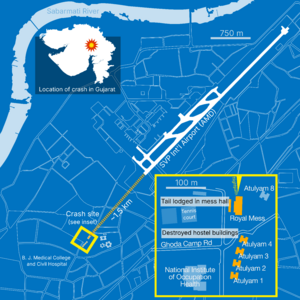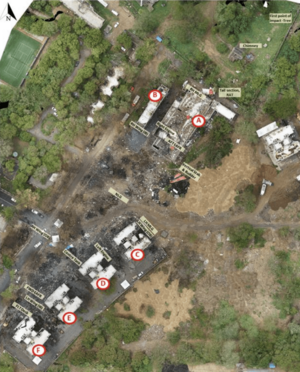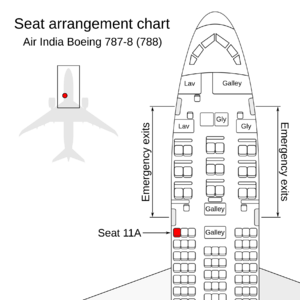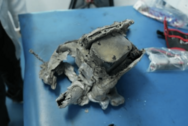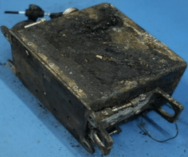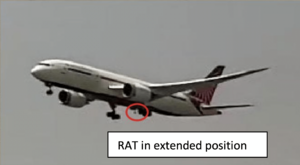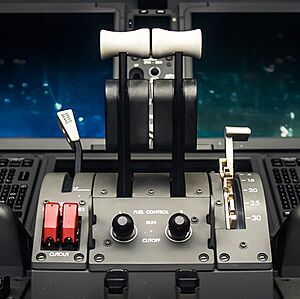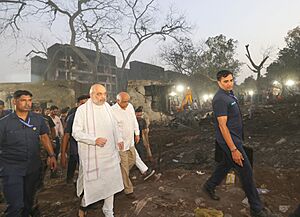Air India Flight 171 facts for kids
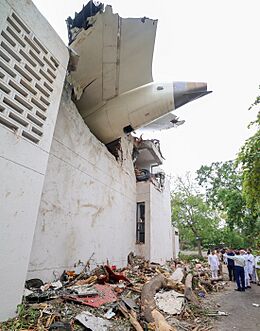
The aircraft's tail section wedged into the hostel block, inspected by Prime Minister Narendra Modi
|
|
| Accident summary | |
|---|---|
| Date | 12 June 2025 |
| Summary | Crashed into a building shortly after takeoff due to loss of thrust from both engines caused by fuel cutoff; under investigation |
| Place | Hostel block, B. J. Medical College, Ahmedabad, India 23°03′17.8″N 72°36′43.7″E / 23.054944°N 72.612139°E |
| Passengers | 230 |
| Crew | 12 |
| Injuries (non-fatal) | 1 |
| Fatalities | 241 |
| Survivors | 1 |
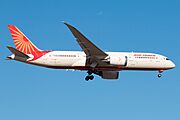 VT-ANB, the aircraft involved, pictured in December 2024 |
|
| Aircraft type | Boeing 787-8 Dreamliner |
| Airline/user | Air India |
| Registration | VT-ANB |
| Flew from | Ahmedabad Airport, Ahmedabad, India |
| Flying to | London Gatwick Airport, Crawley, United Kingdom |
Air India Flight 171 was a regular international flight. It was flying from Ahmedabad Airport in India to London Gatwick Airport in the United Kingdom. On June 12, 2025, the plane crashed about 30 seconds after taking off. This happened at 1:39 PM local time in India.
Almost everyone on board, 230 passengers and all 12 crew members, died. Only one passenger survived. Sadly, 19 more people on the ground were killed, and 67 were seriously hurt. The plane, a Boeing 787-8 Dreamliner, was completely destroyed. It crashed into buildings at B. J. Medical College in Ahmedabad. This was the first time a Boeing 787 Dreamliner had a fatal accident or was completely destroyed since it started flying in 2011.
A first report from India's Aircraft Accident Investigation Bureau said the crash happened because both engines lost power. This was due to their fuel control switches moving to the "CUTOFF" position. Why the switches moved is still being investigated.
| Top - 0-9 A B C D E F G H I J K L M N O P Q R S T U V W X Y Z |
About the Flight
The Aircraft and Its Route
The plane involved in the crash was an 11-year-old Boeing 787-8 Dreamliner. Its registration number was VT-ANB. This aircraft was built in the United States and delivered to Air India in January 2014. It had two powerful GEnx-1B70 engines.
Air India started flying to London Gatwick in 2023. At the time of the crash, they had twelve flights a week to London Gatwick. Five of these flights were from Ahmedabad.
People on Board
There were 242 people on Flight 171. This included 230 passengers and 12 crew members. Among the passengers, 13 were children, and 2 of them were babies.
The passengers came from different countries. There were 169 people from India, 53 from Britain, 7 from Portugal, and one from Canada.
The flight was led by Captain Sumeet Sabharwal, who was 56 years old. He had a lot of flying experience, with about 15,600 hours in the air. He had flown the Boeing 787 for nearly 8,600 hours. The co-pilot, Clive Kunder, was 32. He had about 3,400 flight hours, with 1,100 hours on the Boeing 787. For this flight, Kunder was flying the plane, and Sabharwal was watching the instruments.
The Accident
Flight 171 left its gate at 1:13 PM local time. It was cleared to take off from runway 23 at 1:37:33 PM. The wind was light, and visibility was good.
The plane started moving down the runway at 1:37:37 PM. It reached a height of about 625 feet above sea level. Then, its signal was lost at 1:38:50 PM. The plane reached a top speed of 180 knots (about 207 miles per hour). One of the pilots called for help, saying they had lost power right after takeoff. The plane was in the air for only 32 seconds.
A security camera video near the runway showed the plane going up, then slowly coming down. It crashed about thirty seconds after takeoff, causing a large fire and smoke. Another video taken by someone interested in aviation showed the last few seconds before the crash. The crash site was about 1.5 kilometers (0.9 miles) from the runway.
When the plane hit a building and slid, there were several explosions. Thick smoke followed. The plane crashed into a living area on the Civil Hospital campus. It hit buildings where doctors and students from B. J. Medical College lived. Parts of the plane, like its tail, landed on top of a multi-story building.
This was the first fatal crash for Air India since the bombing of Flight 182 in 1985. It was also the first time a Boeing 787 was completely destroyed or had a fatal crash. This accident was the deadliest aviation accident in India since the 1996 Charkhi Dadri mid-air collision.
Rescue Efforts
The Ahmedabad Fire and Emergency Services Department quickly sent teams. The first call for help came at 1:45 PM. Many firefighters, fire trucks, and water tankers were sent. More than 300 firefighters, 60 fire vehicles, and 20 water bowsers were used. Many ambulances also rushed to the scene. Roads around the crash site were closed to help with rescue work. Fire teams from nearby cities also came to help.
Security teams from Ahmedabad Airport were among the first to arrive. Teams from the Indian Army, Border Security Force, and other national disaster response groups also helped. A military hospital was ready to receive injured people.
The Ahmedabad Municipal Corporation sent over 150 vehicles, including diggers and trucks, to clear the debris. They also sent engineers and health workers. All flights at the airport were stopped for a while, but some resumed later that day.
Victims and Survivors
All but one of the 230 passengers and all 12 crew members died. On the ground, 19 more people were killed, and 67 were seriously hurt. By June 13, police had released six bodies to their families. Among those who died was Vijay Rupani, a former leader of Gujarat. His body was identified using DNA identification. Identifying all victims was difficult due to the crash's impact. By June 28, 2025, DNA tests had confirmed the identities of all 260 people who died.
At least 50 medical students from the hostel buildings were taken to the hospital. The college dean said most students escaped, but about 10 to 12 were caught in the fire.
A 40-year-old British man, Vishwash Kumar Ramesh, was the only survivor. He was sitting in seat 11A, next to an emergency exit. Ramesh said the part of the plane where he was sitting broke off and landed on the ground floor of the hostel. He escaped through an opening where the emergency exit had broken. A video showed him walking away from the crash by himself before being led to an ambulance. Doctors said he was confused but had only minor injuries, including burns to his left hand. He left the hospital after five days. His brother, who was in a different row, did not survive.
The Investigation
India's Aircraft Accident Investigation Bureau (AAIB) is investigating the crash. Teams from the United Kingdom and the United States are also helping.
On June 13, about 28 hours after the crash, one of the plane's two flight recorders was found on a building rooftop. These recorders record both flight data and cockpit voices. The second recorder was found on June 16 among the crash debris. Both recorders were sent to a lab in Delhi to get the information from them. Data from the front recorder was successfully downloaded on June 25.
India's aviation authority and Air India also started their own investigations. On June 13, the aviation authority ordered Air India to do extra technical checks on its Boeing 787 planes. They also told Air India to do more maintenance and checks on the fuel systems and engine controls of these planes.
First Report
On July 8, the AAIB released a first report about what they had found so far.
According to the flight recorder data, the plane started its takeoff at 1:37:37 PM. It reached takeoff speed at 1:38:35 PM and lifted off the runway about four seconds later. At 1:38:42 PM, when the plane reached its fastest recorded speed, both engines shut down. This happened because their fuel control switches moved from "RUN" to "CUTOFF" one second apart. The engines immediately started losing power. The cockpit voice recording captured one pilot asking the other why he had cut off the fuel. The second pilot replied that he had not. The report did not say which pilot said what. Airport cameras showed no birds near the flight path. The plane started losing height before it left the airport area.
At 1:38:47 PM, with both engines losing power, a special emergency system called the ram air turbine (RAT) automatically came out. This system provides emergency power. At 1:38:52 PM, the fuel switch for the first engine moved back to the "RUN" position. Four seconds later, the switch for the second engine also moved back. At this point, the engine's computer system tried to restart the engines automatically.
Around 1:39:05 PM, one of the pilots made a "mayday" distress call. The air traffic controller asked for the flight's call sign but got no answer.
By the end of the flight data recording at 1:39:11 PM, the first engine had restarted and was speeding up. The second engine had also restarted, but its speed was still dropping. The computer system was adding more fuel to try and get it to full power.
The report found that the engine power levers were in the idle position when found. However, the flight data showed that both throttles had been at takeoff power until the crash. The flap controls were set correctly for takeoff.
The report did not find any mechanical problems with the plane or its engines. It also did not suggest any immediate safety actions for other airlines using the Boeing 787. The reason why the fuel switches moved is still being investigated.
On the 787, the fuel control switches are used to start and stop the engines on the ground. In the air, they are used to manually shut down or restart an engine if there's a problem. Moving a switch in flight immediately cuts off fuel to the engine, causing it to lose power. To prevent accidental movement, each switch has a metal lock that requires it to be pulled up before it can be moved. There are also guards on the sides of the switches.
The first report mentioned that in 2018, a warning was issued about similar fuel switches on Boeing 737 planes. These switches sometimes had their lock mechanisms not working correctly. No record was found that Air India had checked the incident aircraft for this issue, though it was not required. The throttle control part of the plane was replaced twice, in 2019 and 2023, but not because of problems with the fuel cutoff switches. No issues with the cutoff switches on this specific plane had been reported since 2023.
Reactions to the Crash
Prime Minister Narendra Modi visited the crash site on June 13. He also went to the hospital to meet the only survivor from the plane and those injured on the ground. Home Minister Amit Shah spoke with the Chief Minister of Gujarat, Bhupendra Patel. Patel said officials were told to start "immediate rescue and relief operations" and to make arrangements quickly.
British Prime Minister Keir Starmer sent his sympathies. The UK Foreign Office set up special teams in India and the UK to help. In London, on June 14, there was a one-minute silence to remember the victims. Senior members of the royal family wore black armbands at the request of King Charles III.
Air India's chairman, Natarajan Chandrasekaran, called Flight 171 a "tragic accident." He expressed his deepest sadness to those affected. He said the airline was focused on helping victims and their families. Air India's CEO, Campbell Wilson, said it was a "difficult day" for the airline. He said special teams would provide support. He faced some criticism for his speech. Another Air India 787 flight, with Wilson on board, returned to Delhi so he could help with the crisis. On July 3, it was reported that Air India pilots practiced the Flight 171 takeoff in a flight simulator. They tried to create electrical problems that could cause both engines to stop.
Boeing CEO Kelly Ortberg canceled his plans to attend a big air show. He offered his condolences and said he would send experts to help investigators. Boeing's stock prices dropped almost 9% after the crash. GE Aerospace, which made the engines, said it would send a team to India and analyze the cockpit data.
After the first report was released, pilot groups in India criticized what they called "reckless" suggestions about pilot actions. They also said they were "surprised at the secrecy" of the investigation.
On July 17, the AAIB asked the public and media not to guess about what happened.
Aftermath
On the day of the crash, Tata Group, which owns Air India, announced compensation for the families of those who died. They also said they would cover medical costs for the injured. Under international rules, Air India is responsible for paying compensation to the families of each passenger who died. The Tata group later also offered compensation to the people injured or killed on the ground. They also plan to help rebuild the damaged college building. Tata Group suspended four Air India SATS officers for celebrating shortly after the crash.
Air India stopped using flight number AI171 and its return flight AI172. The route between Ahmedabad and London Gatwick is now called AI159 and AI160. Air India Express, another airline, also stopped using flight number IX171.
See also
 In Spanish: Vuelo 171 de Air India para niños
In Spanish: Vuelo 171 de Air India para niños
- List of accidents and incidents involving commercial aircraft
- List of sole survivors of aviation accidents and incidents
- List of deadliest aircraft accidents and incidents
- List of aircraft accidents and incidents by number of ground fatalities
- 2025 in aviation


